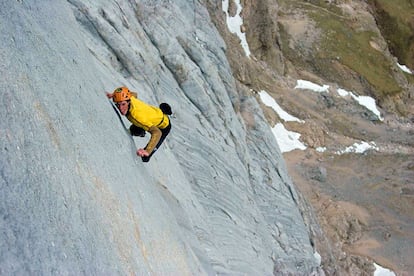Climbing without a rope, between freedom and psychopathy
The free solo is not a recent trend, but a historical mountaineering tradition that modern psychology regards with amazement

On May 18, Martin Feistl, a talented 27-year-old German mountaineer, chose to climb a 270-meter wall without a partner. He could also have decided to do it by belaying himself using a laborious technique, but he preferred to take on the challenge alone. The technical difficulty of the chosen route was no higher than 6b, an intermediate grade, especially for someone accustomed to much higher points on the scale. At some point, he fell, and having dispensed with the rope he died when he crashed to the ground. Just a few days later, Alex Honnold broke the solo speed record on the Salathé Wall of El Capitan in California’s Yosemite Valley. The news was, in this case, that the all-around solo artist had climbed without a partner but with rope, self- belaying as he ascended. “Self-belaying is a hassle, a tedious thing... but I had to do it because my partners failed me and I was left alone,” explained the North Face athlete shortly after spending 11 hours and 18 minutes on the route, nine hours less than the previous record. Days earlier, on his return to the valley that has made him world famous, Honnold had completed a couple of free-solo ascents, while novices continue to wonder what leads a person to dispense with the rope to climb free solo. Bravery? Disregard for life? Suicidal impulse? Overconfidence? Free-soloing, however, is not a modern trend. It goes back a long way.
In the origins of climbing and mountaineering, anyone who climbed, whether with or without a rope, did so practically free solo: as there were no rock pitons or self-protection measures, any fall could end in the death of the leader and his companions. For practical purposes, the rope served only to help the second climber to ascend and descend. The rope leader’s life always depended on not slipping and falling. The need to explore could explain taking on such risks. In 1924, the Austrian Paul Preuss was only 24 when he revealed himself as a gifted climber with a groundbreaking philosophical proposal: climbing with a rope was more dangerous than climbing without one. Three years later, his body was found at the base of the north face of the Mandlkogel, a dark summit of dubious limestone.
Before his death, Preuss pulled off mind-blowing unroped ascents and got on the nerves of all those climbers who at the time confused climbing with ascending. The latter used ropes and rock pitons to hold on to, lending a certain illusion of security. But at the beginning of the 20th century, the pitons were of poor quality, the rock in the Dolomites is always suspiciously flimsy, and the ropes broke with frightening ease. Numerous climbers of the era perished. We had to wait until the 1950s to see the advent of harnesses and nylon ropes, which were much more reliable than those made of hemp. Now, yes, falling does not mean death. But Preuss had managed to sow a seed of authenticity that earned the respect of many and inspired others like Reinhold Messner himself.
Many climbers, professional or not, point out that today it makes no sense to climb without a rope, and argue that Preuss’ precepts were delusions. The Austrian advocated that a climber should measure himself against challenges that he could climb and descend, dispensing with rope. But rock cracks, the holds get wet and slippery... and when this happens, the climber loses everything. “I have fallen so many times in places where I would never have thought it possible to fall, that it is clear to me that I will never climb without a rope,” says Adam Ondra, the strongest climber of the 21st century. Even so, history offers numerous examples of amazing ascents without a rope... and, also, terrible tragedies.
Adi Mayr (1961), Adolf Derungs (1962) and Dieter Machard (1963) all perished trying to complete the first solo ascent of the north face of the Eiger. Because the solitary exercise grants prestige. It is the sublimation of climbing, absolute freedom, lightness, speed, simplicity, communion with an environment that attracts and repels. It means being wild in a wild space. But the free solo is not within the reach of just anyone, which is why every ascent without a rope leads the climbing community to wonder what kind of psychology moves men and women to dispense with a life insurance policy such as a rope.
Josep Font, a psychologist at the Sant Cugat high performance center in Spain, snorts and wonders what is in the minds of those who choose to free solo. “For this type of person, the challenge is not sporting, but facing fear and overcoming it. [MotoGP rider] Marc Márquez’s goal is to win races, even if he has to face the fear of crashing. On the other hand, the solo climber does not face a sporting challenge, but a psychological one, which is to face fear and manage to climb without anything happening to them. The challenge is to overcome the same dangerous situation. In 1979, the American psychologist Marvin Zuckerman, a personality researcher, established that there are a number of people who can be defined as thrill seekers: they pursue new and exciting experiences even if they involve risks. Those who climb without a rope need a strong stimulation with respect to danger, i.e., something that puts them in terrifying situations.”
Historically, free soloists have taken on challenges that are several rungs below their capabilities, a decision that allows them to climb with a wide margin of safety. Next, the choice of rock type is critical. “On granite cracks where you climb with the technique of embedding hands, fingers, and feet in the rock cracks, I find it impossible to fall,” Alex Honnold often explains to justify his challenges on El Capitan. But Honnold has made hair-raising ascents over tiny limestone rock holds, where his fingers cling to holds a few millimeters long and the tips of his feet seek pressure and grip on tiny reliefs in the rock. Until the Oscar-winning documentary Free Solo captured Honnold’s climb on the Freerider route on El Capitan, with difficulty levels of up to 7c+ (i.e., very difficult, with random moves), Hansjörg Auer held the unofficial record for the most outlandish, technical, and exposed free ascent. In 2007, Auer climbed the Attraverso il Pesce route (7b+) on the Marmolada Wall in the Dolomites, an extremely technical, demanding route with extraordinarily small holds. The Austrian, who had established the route with rope, fell several times in the key section, which did not prevent him from taking on the challenge without rope. Auer died in an avalanche in 2019.

In 2022, 25-year-old Italian Jonas Hainz, son of the celebrated mountaineer Christoph Hainz, died when he fell on Mount Magro. He was climbing without a rope. Just a few months earlier he had completed a mind-blowing solo by climbing the Moulin Rouge (7b+, 400m, Dolomites), opened by his father in 2002. However, most of the great all-round solo aces do not die during one of their ascents. Dean Potter, the man who climbed without a rope and at times with a small parachute on his back, lost his life after a failed wingsuit jump. Dan Osman died after a rope jump when his rope snapped. Kurt Albert perished on a via ferrata... but John Bachar, the all-around solo ace who inspired Honnold, died in 2009 when he fell on a low-difficulty route. In Europe, ropeless climbing is perceived among the climbing community as a barely understandable and justifiable exercise. However, the United States has a great tradition of soloing, and its community respects the decision to go rope-free.
If most soloing takes place out of the spotlight, documentaries have pulled the practice from its relative anonymity, engaging all types of viewers: Free Solo will remain forever in the retina, as much as the unbridled races of Ueli Steck on the north face of the Eiger. And it’s not just about the men: American Steph Davis and Frenchwoman Catherine Destivelle both have breathtaking solo ascents on their resumes. “It may sound harsh, but ultimately among those who climb without a rope there is a certain psychopathic deviation of the personality. These are people who are insensitive to both reward and punishment, even though they may be very intelligent people. They know they can lose everything, but it doesn’t affect them much,” says Font.
Sign up for our weekly newsletter to get more English-language news coverage from EL PAÍS USA Edition
Tu suscripción se está usando en otro dispositivo
¿Quieres añadir otro usuario a tu suscripción?
Si continúas leyendo en este dispositivo, no se podrá leer en el otro.
FlechaTu suscripción se está usando en otro dispositivo y solo puedes acceder a EL PAÍS desde un dispositivo a la vez.
Si quieres compartir tu cuenta, cambia tu suscripción a la modalidad Premium, así podrás añadir otro usuario. Cada uno accederá con su propia cuenta de email, lo que os permitirá personalizar vuestra experiencia en EL PAÍS.
¿Tienes una suscripción de empresa? Accede aquí para contratar más cuentas.
En el caso de no saber quién está usando tu cuenta, te recomendamos cambiar tu contraseña aquí.
Si decides continuar compartiendo tu cuenta, este mensaje se mostrará en tu dispositivo y en el de la otra persona que está usando tu cuenta de forma indefinida, afectando a tu experiencia de lectura. Puedes consultar aquí los términos y condiciones de la suscripción digital.
More information
Archived In
Últimas noticias
Most viewed
- Reinhard Genzel, Nobel laureate in physics: ‘One-minute videos will never give you the truth’
- Oona Chaplin: ‘I told James Cameron that I was living in a treehouse and starting a permaculture project with a friend’
- Pablo Escobar’s hippos: A serious environmental problem, 40 years on
- Chevy Chase, the beloved comedian who was a monster off camera: ‘Not everyone hated him, just the people who’ve worked with him’
- Why we lost the habit of sleeping in two segments and how that changed our sense of time









































